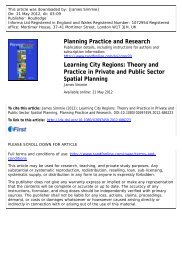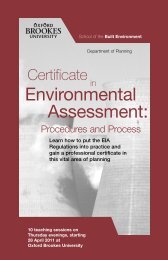History Matters: Path dependence and innovation in British city ...
History Matters: Path dependence and innovation in British city ...
History Matters: Path dependence and innovation in British city ...
Create successful ePaper yourself
Turn your PDF publications into a flip-book with our unique Google optimized e-Paper software.
Table 17: Patent applications per capita<br />
Indicator<br />
Time series<br />
Data source<br />
Geographic basis<br />
Def<strong>in</strong>itions<br />
Comments<br />
Annual EPO patent applications per million resident population.<br />
1977 to 2002 (annual); although data for some <strong>city</strong>-regions is miss<strong>in</strong>g for some of the earlier years.<br />
Eurostat, Regio database; plus ONS, mid-year population estimates.<br />
Data for NUTS2 areas is best-fit to 1998 TTWA boundaries.<br />
Applications are broken down by IPC section <strong>and</strong> class.<br />
NUTS2 areas do not provide a good geographic fit to 1998 TTWA (<strong>city</strong>-region) boundaries. In<br />
some cases, the NUTS2 area <strong>in</strong>cludes more than one <strong>city</strong>-region, <strong>and</strong> separate figures cannot<br />
therefore be obta<strong>in</strong>ed for these cities (e.g. Cambridge & Norwich; Leeds & Wakefield).<br />
Table 18: Employment diversity <strong>in</strong>dex<br />
Indicator<br />
Time series<br />
Data source<br />
Geographic basis<br />
Def<strong>in</strong>itions<br />
Herf<strong>in</strong>dahl-Hirschman diversity <strong>in</strong>dex for the <strong>city</strong>-region’s employment base.<br />
1981, 1991, 2005 (economic trough years).<br />
ONS, 1981 Census of Employment; 1991 Annual Employment Survey; 2005 Annual Bus<strong>in</strong>ess<br />
Inquiry.<br />
Data for local authority districts is best fit to 1998 TTWA boundaries (pre-1996 districts are<br />
used for 1981 data).<br />
Herf<strong>in</strong>dahl-Hirschman diversity <strong>in</strong>dex is calculated as the sum of the squared percentage<br />
employment shares of all 3-digit sectors of the 1992 SIC (except for 1981 which is based on<br />
the 1980 SIC at 3-digit level).<br />
Higher <strong>in</strong>dex values <strong>in</strong>dicate a less sectorally diverse employment structure.<br />
The <strong>in</strong>dex can be st<strong>and</strong>ardised by multiply<strong>in</strong>g the H-H <strong>in</strong>dex value by the number of sectors<br />
<strong>and</strong> divid<strong>in</strong>g by 100; an equal distribution of employment across all sectors would then<br />
produce a st<strong>and</strong>ardised <strong>in</strong>dex value of 100.<br />
Comments<br />
The 1981 <strong>in</strong>dex is not directly comparable with that for 1991 <strong>and</strong> 2005, due to the use of a<br />
different version of the SIC.<br />
Table 19: Employment diversity with<strong>in</strong> sectors<br />
Indicator<br />
Time series<br />
Data source<br />
Geographic basis<br />
Def<strong>in</strong>itions<br />
Herf<strong>in</strong>dahl-Hirschman diversity <strong>in</strong>dex, show<strong>in</strong>g employment diversity at 3-digit level with<strong>in</strong><br />
2-digit sectors (1992 SIC).<br />
2005 only.<br />
ONS, 2005 Annual Bus<strong>in</strong>ess Inquiry.<br />
Data for local authority districts is best-fit to 1998 TTWA boundaries (pre-1996 districts are<br />
used for 1981 data).<br />
See def<strong>in</strong>ition of Hirf<strong>in</strong>dahl-Hirschman <strong>in</strong>dex above.<br />
Higher <strong>in</strong>dex values <strong>in</strong>dicate less employment diversity with<strong>in</strong> the 2-digit sector.<br />
To allow comparisons between 2-digit sectors, all <strong>in</strong>dex values are st<strong>and</strong>arised by multiply<strong>in</strong>g<br />
the H-H <strong>in</strong>dex value by the number of 3-digit sub-sectors <strong>and</strong> then divid<strong>in</strong>g by 100. With an<br />
equal distribution of employment across all 3-digit sub-sectors, the st<strong>and</strong>ardised <strong>in</strong>dex value<br />
will be 100, regardless of the number of sub-sectors.<br />
Comments<br />
None.<br />
86













